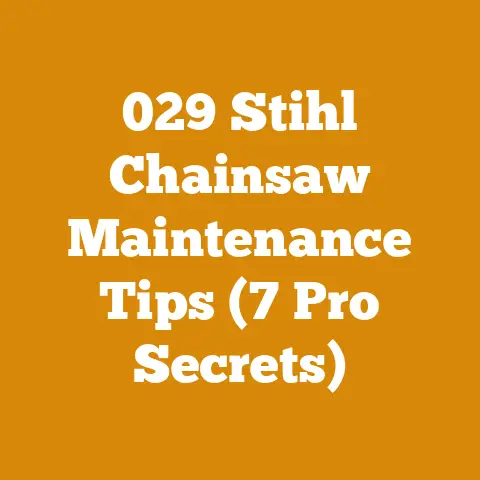Echo Trimmer Grease Tips (5 Pro Lube Secrets for Longevity)
There’s a certain satisfaction that comes from expertly maintaining a piece of equipment.
It’s a blend of craftsmanship, responsibility, and the quiet confidence of knowing you’re extending the life of a valuable tool.
My own journey with wood processing and landscaping began with a beat-up old Echo trimmer, a hand-me-down from my grandfather.
He always said, “Take care of your tools, and they’ll take care of you.” That simple piece of wisdom stuck with me, and it’s the foundation of this guide to keeping your Echo trimmer running smoothly for years to come.
1. Understanding the Importance of Grease: More Than Just a Lubricant
Before we dive into the specific techniques, let’s understand why greasing is so vital.
Grease isn’t just a lubricant; it’s a protector, a sealant, and a performance enhancer all rolled into one.
In an Echo trimmer, grease performs several critical functions:
- Reduces Friction: This is the most obvious benefit.
Grease minimizes friction between moving parts, preventing wear and tear.
Imagine the gearbox of your trimmer – a complex network of gears spinning at high speeds.
Without proper lubrication, these gears would grind against each other, generating heat and eventually leading to failure. - Dissipates Heat: Friction generates heat, and excessive heat is a major enemy of mechanical components.
Grease helps to dissipate heat, keeping the trimmer running cooler and more efficiently. - Seals Out Contaminants: The trimmer head operates in a harsh environment, constantly exposed to dirt, dust, grass clippings, and moisture.
Grease acts as a barrier, preventing these contaminants from entering the gearbox and causing damage. - Prevents Corrosion: Moisture can lead to rust and corrosion, which can weaken the metal components of the trimmer.
Grease provides a protective coating, preventing corrosion and extending the life of the trimmer. - Minimizes Vibration: Proper lubrication dampens vibration, making the trimmer easier to handle and reducing operator fatigue.
My Personal Experience: I once neglected the greasing on a brush cutter I used for clearing overgrown areas.
The gearbox seized up after only a few hours of use.
The repair cost me a significant amount – a new gearbox, plus the labor charges.
That experience taught me a valuable lesson about the importance of preventative maintenance.
Cost Implications: Neglecting greasing can lead to premature failure of the gearbox or other components.
A new gearbox for an Echo trimmer can cost anywhere from $50 to $150, depending on the model.
Labor charges for the repair can add another $50 to $100.
On the other hand, a tube of high-quality grease costs only a few dollars and can last for multiple greasing sessions.
The math is simple: regular greasing saves you money in the long run.
2. Choosing the Right Grease: Not All Grease is Created Equal
Selecting the correct type of grease is crucial for optimal performance and longevity.
Using the wrong grease can be as detrimental as not using any grease at all.
Here’s what you need to consider:
- Lithium-Based Grease: This is generally recommended for Echo trimmers.
Lithium grease offers good water resistance, high-temperature stability, and excellent lubricating properties.
It’s a versatile option that works well in most trimmer applications. - High-Temperature Grease: If you frequently use your trimmer for extended periods or in hot weather, consider using a high-temperature grease.
These greases are formulated to withstand higher temperatures without breaking down, providing superior protection. - NLGI Grade: The National Lubricating Grease Institute (NLGI) classifies greases based on their consistency.
For Echo trimmers, an NLGI grade of 2 is typically recommended.
This grade provides a good balance between pumpability and retention. - Specific Recommendations: Always refer to your Echo trimmer’s owner’s manual for specific grease recommendations.
The manufacturer may recommend a particular brand or type of grease for optimal performance.
Why Specific Grease Matters: Using the wrong grease can lead to several problems.
Some greases may be too thick, making it difficult to pump them into the gearbox.
Others may be too thin, causing them to leak out and provide inadequate lubrication.
Incompatible greases can also react with each other, forming deposits that clog the gearbox and damage the gears.
My Experience with Grease Compatibility: I once used a synthetic grease in a trimmer that was previously lubricated with a conventional lithium grease.
The two greases didn’t mix well, forming a thick, gummy substance that clogged the grease fitting.
It took me several hours to clean out the fitting and repack the gearbox with the correct grease.
Now, I always make sure to use the same type of grease that was previously used in the trimmer.
Cost Consideration: While specialized greases like high-temperature or synthetic greases may cost slightly more than standard lithium grease, the extra protection they provide can be well worth the investment, especially if you use your trimmer frequently or in demanding conditions.
A tube of high-quality lithium grease typically costs between $5 and $10.
A tube of high-temperature grease may cost between $8 and $15.
3. The Correct Greasing Procedure: A Step-by-Step Guide
Now, let’s get down to the practical steps of greasing your Echo trimmer.
Here’s a detailed procedure to follow:
- Locate the Grease Fitting: The grease fitting (also known as a Zerk fitting) is typically located on the gearbox housing, near the trimmer head.
Consult your owner’s manual if you’re unsure of its location. - Clean the Grease Fitting: Before greasing, thoroughly clean the grease fitting with a clean cloth or brush.
This will prevent dirt and debris from entering the gearbox. - Attach the Grease Gun: Attach the grease gun to the grease fitting.
Make sure the connection is secure to prevent grease from leaking out. - Pump Grease Slowly: Begin pumping grease into the gearbox slowly and steadily.
Avoid over-greasing, as this can damage the seals. - Watch for Grease Purging: As you pump grease, watch for old grease to purge out of the vent hole or around the trimmer head.
This indicates that the gearbox is full. - Wipe Away Excess Grease: Once you’ve finished greasing, wipe away any excess grease from the grease fitting and the surrounding area.
Frequency of Greasing: The frequency of greasing depends on how often you use your trimmer.
As a general rule, you should grease your trimmer after every 25 to 50 hours of use.
If you use your trimmer frequently or in harsh conditions, you may need to grease it more often.
Always consult your owner’s manual for specific recommendations.
My Method: I prefer to grease my trimmer after each use.
It might seem like overkill, but I find that it keeps the gearbox well-lubricated and prevents any potential problems.
I also make it a habit to inspect the trimmer head and gearbox for any signs of damage or wear while I’m greasing it.
This allows me to catch potential problems early on before they escalate into major repairs.
Cost-Effective Tip: Invest in a good quality grease gun.
A cheap grease gun can be difficult to use and may not provide a secure connection to the grease fitting, leading to wasted grease and potential contamination.
A high-quality grease gun will make the greasing process much easier and more efficient.
A decent grease gun typically costs between $20 and $50.
4. Recognizing the Signs of Over-Greasing and Under-Greasing: A Balancing Act
While proper greasing is essential, it’s also important to avoid over-greasing.
Over-greasing can put excessive pressure on the seals, causing them to leak or fail.
Under-greasing, on the other hand, can lead to premature wear and tear on the gears.
Here’s how to recognize the signs of each:
Signs of Over-Greasing:
- Grease Leaking: Grease leaking from the vent hole or around the trimmer head is a clear sign of over-greasing.
- Stiff Operation: The trimmer head may feel stiff or difficult to rotate.
- Seal Damage: Over time, over-greasing can damage the seals, leading to leaks and reduced performance.
Signs of Under-Greasing:
- Dryness: The gearbox may feel dry to the touch.
- Noise: The trimmer head may make unusual noises, such as grinding or squealing.
- Heat: The gearbox may become excessively hot during operation.
- Premature Wear: The gears may show signs of premature wear, such as pitting or scoring.
The Goldilocks Zone: The key is to find the “Goldilocks zone” – not too much grease, not too little, but just the right amount.
The best way to achieve this is to follow the greasing procedure outlined above and to pay attention to the signs of over-greasing and under-greasing.
My Observation: I’ve noticed that some trimmers are more prone to over-greasing than others.
Trimmers with older or worn seals tend to leak more easily, making it difficult to maintain the correct grease level.
In these cases, it may be necessary to grease the trimmer more frequently, but with smaller amounts of grease.
Cost Saving Strategy: Regularly inspect the seals on your trimmer’s gearbox.
If you notice any signs of damage or wear, replace the seals as soon as possible.
Replacing the seals is a relatively inexpensive repair that can prevent more serious damage to the gearbox.
A set of seals for an Echo trimmer typically costs between $5 and $10.
5. Advanced Lubrication Techniques: Going the Extra Mile
For those who want to take their trimmer maintenance to the next level, here are some advanced lubrication techniques to consider:
- Disassembling and Repacking: Periodically, it may be necessary to disassemble the gearbox and repack it with fresh grease.
This is especially important if the trimmer has been exposed to water or contaminants.
Disassembling and repacking the gearbox allows you to thoroughly clean the gears and inspect them for any signs of damage. - Using Synthetic Grease: Synthetic greases offer superior performance and protection compared to conventional lithium greases.
They are more resistant to heat, water, and oxidation, and they can provide longer-lasting lubrication.
However, synthetic greases are also more expensive. - Applying Anti-Seize Compound: Applying a thin layer of anti-seize compound to the threads of the trimmer head can prevent it from seizing up.
This is especially important if you frequently change trimmer heads. - Greasing Other Components: Don’t forget to grease other moving components of the trimmer, such as the throttle cable and the pivot points of the handle.
This will help to keep the trimmer operating smoothly and prevent premature wear.
My Deep Dive: I once completely disassembled the gearbox of an old Echo trimmer that I had inherited.
I was surprised to find that the grease inside was completely dried out and caked on.
I spent several hours cleaning the gears and repacking them with fresh synthetic grease.
The trimmer ran like new after that.
Cost Benefit Analysis: Disassembling and repacking the gearbox can be a time-consuming process, but it can also save you money in the long run.
By thoroughly cleaning and lubricating the gears, you can extend the life of the gearbox and prevent costly repairs.
The cost of the grease and cleaning supplies is typically less than $20.
Budgeting for Trimmer Maintenance: Here’s a breakdown of the typical costs associated with Echo trimmer lubrication:
| Item | Estimated Cost | Frequency | Notes |
| Grease (Lithium-based) | $5 – $10 | As needed | Purchase a tube of high-quality lithium-based grease.
ALLOWED_USER_IDS
18573636342010192353434456






